 The British
Racing Motors (unofficial)
information centre.
The British
Racing Motors (unofficial)
information centre. The British
Racing Motors (unofficial)
information centre.
The British
Racing Motors (unofficial)
information centre.
- the "other" cars -
(More Photos in my Flickr albums - have a look!)
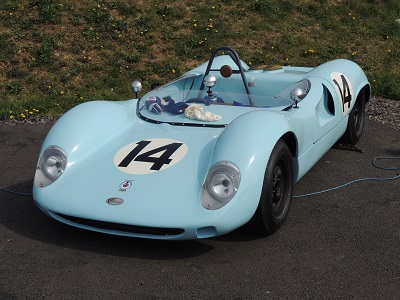 Brabham BT8 - BRM
Brabham BT8 - BRM
(Photograph - Brabham
BT8 - BRM SC-5-64 - BRM Track Day, Blyton -
24 April 2019) ..................... More Photos in my Flickr album - BRM Track Day - Blyton 24 April 2019)
First raced in 1964 the type was designed for the 2-litre sports-racing car category and originally powered by a 1,880cc BRM V8.
In 2019 it was running with a full two litre unit.
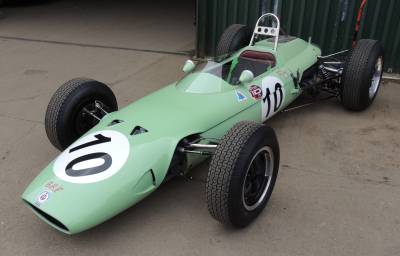 BRP-BRM
V8 1.5litre Formula One
BRP-BRM
V8 1.5litre Formula One
(Photograph - BRM Track Day, Blyton - 22 April
2015) ..................... More Photos in my Flickr album - BRM Track Day - Blyton 22 April 2015)
The British Racing Partnership (including the Stirling Moss family and Ken Gregory) ran various Formula One cars that they ran as private entries in the 1950s and early 1960s. The team eventually became a manufacturer in their own right.
The first appearance of the Tony Robinson BRP monococque was in the Belgian Grand Prix at Spa 1963. The team withdrew at the end of 1964. The cars used BRM engines and gearboxes.
Chevron-BRM
Constructor Derek Bennett’s superb Bolton-built Chevrons were normally powered by Cosworth-Ford or BMW 4-cylinder units but for 1966 the company’s ardent supporter David Bridges ordered a B5 Coupe to accept a BBM V8 engine. Brian Redman and Chris Williams drove the car in the 1967 Brands Hatch 6-Hours without success, though future BRM driver Brian finished 2nd with the car at the Norisring, in Nuremberg, Germany. This Chevron-BRM B5 also appeared in British events, Derek Bennett himself finishing 4th with it at Crystal Place, and John Bridges 2nd at Silverstone. In 1967 the car was driven by J. Collison (2nd at Oulton Park) and in 1969 by Willie Green who enjoyed considerable UK success. The car was then acquired by Willie Tuckett and converted by Peter Sadler into the 1970 Gropa-BRM (see below). As late as 1972 Peter Hanson and Alan Jones were entered for the BOAC 1000 in a later Chevron-BRM B16, but it did not emerge.
(From BRM - The Saga Of British racing Motors Volume 3 by Doug Nye)
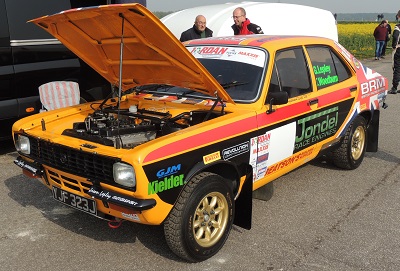 Chrysler
(Hillman) Avenger 1.6litre
Chrysler
(Hillman) Avenger 1.6litre
(Photograph - BRM Track Day, Blyton - 24
April 2019) ..................... More Photos in my Flickr album - BRM Track Day - Blyton 24 April 2019)
This high performance version of the family run-about used a "Chrysler-BRM" 1600cc Avenger engine. The BRM conversion used a 16-valve alloy head operated by chain drive twin cams.
The engine capacities were 1598cc and also 1798cc & 2000cc (which gave 205bhp). The car gave Chrysler/Hillman a package powerful enough to compete in rallying. Production of the car ran between 1974 and 1977.
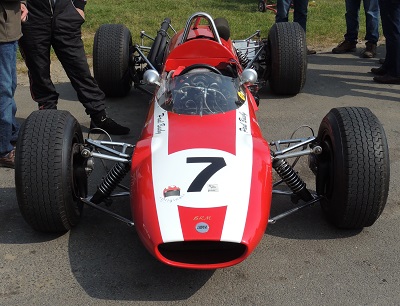 Cooper T82-BRM 4cyl. Formula Two
Cooper T82-BRM 4cyl. Formula Two
(Photograph - Cooper T82
F2-2-66 - BRM Track Day, Blyton - 24 April
2019) ..................... More Photos in my Flickr album - BRM Track Day - Blyton 24 April 2019)
Designed for the 1966 Formula Two season with a BRM P80 engine (straight 4 one litre).
Cooper T86-BRM V12 3litre Formula One
In 1968 Brian Redman & Lucien Bianchi scored third
places at Spain & Monaco during the last year of the Cooper
Grand Prix team's career.
Daren-BRM
Like Chevron, Daren normally employed Ford-based engines but in September 1971 former Jerboa-BMC exponent Jack Wheeler and Martin Davidson appeared in the Nurburgring 500Kms classic in their smart new Daren Mark 3 powered by the ex-Tuckett (Chevron B5/Gropa) ‘2-litre’ BRM V8 engine. It retired with a serious oil leak ?ooding the electrics, a similar problem side-lining the pair in the Vallelunga 2-Hours. Wheeler/Davidson’s Daren-BRM reappeared in the Barcelona 1,000Kms that October but failed to ?nish. The Daren-BRM was entered for the 1972 Brands Hatch 1,000Kms, but failed to qualify, then suffered terminal ignition trouble on the opening lap of the Targa Florio, and retired from the Nurburgring 1,000Kms after 8 laps, due to overheating. Davidson finished 15th in Heat 2 of the European Championship race at Silverstone. There was little to show for tremendous effort and enthusiasm.
(From BRM - The Saga Of British racing Motors Volume 3 by Doug Nye)
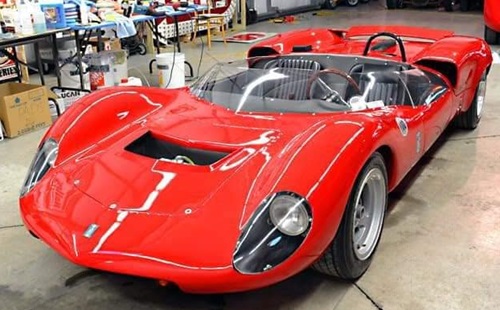 De Tomaso-BRM Sport 1000
De Tomaso-BRM Sport 1000
(Photograph - © Artcurial Motorcars | Artcurial.
(Last amended - 23 November 20123 .
The chassis ” VL1609 ” was fitted with the BRM 998cc four cylinder engine.
Sold by the factory in 2004.
Elva-BRM
Malcolm Wayne’s new Elva Mark 8 sports-racing car was powered by the BRM V8 engine allegedly drawn from Ian Raby’s Formula 1 Brabham-BRM BT3. The car ran in the 1966 Tourist Trophy at Oulton Park but was reportedly beset by fuel-feed problems. Before the end of that season Wayne had replaced the worrisome BRM V8 with an easier to operate conventional 4-cylinder BMW engine.
(From BRM - The Saga Of British racing Motors Volume 3 by Doug Nye)
Felday-BRM
The Felday was the most technically interesting of all the BRM V8- engined sports car designs. Former RAC British Hill-Climb Champion Peter Westbury of Felday Engineering in Surrey had built strong relationships with both BBM and the 4-wheel-drive pioneers, Harry Ferguson Research Ltd - as described in Volume 2 of this Saga. For 1965, he devised a new monocoque-chassised sports-racing car using the ‘2-litre’ BRM V8 engine and a Ferguson 4-wheel drive system. He had already built and campaigned a conventional rear-drive Lotus 23 with BRM V8 engine for the 1964 European Mountain Championship, before taking over the hitherto unraced BRM P67
4-wheel-drive single-seater for hill-climb competition. His Felday-BRM Mark 4 sports car featured an unusual transverse-mounted coil-spring front suspension system. It was launched in January 1965 but Peter’s commitments delayed its debut race until the Boxing Day Brands Hatch meeting. Driven by Mac Daghorn, it
immediately won the Formule Libre event there, before Westbury finished 2nd in the sports car race. Suitably encouraged, a full British season was planned for 1966, starting at Mallory Park, where Westbury won the Libre race and Daghorn the sports car event. Daghorn had several further club-race successes, and against stronger opposition led the field at the Easter Goodwood meeting until a spin relegated him to finish 3rd. At May Silverstone he ran 2nd in wet conditions amongst much more potent machinery, only to strike trouble. Later, however, he finished 2nd in class in the British Grand Prix supporting race, at Brands Hatch. World Champion Jim Clark then drove the Felday-BRM 4 at Brands in the prestigious Guards Trophy race on August Bank Holiday Monday. He won the 2-litre class in Heat One, only to retire from Heat Two. Meanwhile, Peter Westbury finished 6th in the year’s Guards
Championship for sports cars. Ironically, having been designed by a hill-climb champion as a circuit-racing car, the Felday 4 finally ended its contemporary competitive life on the hills, campaigned by BRM enthusiast John McCartney, 1967-70.
(From BRM - The Saga Of British racing Motors Volume 3 by Doug Nye)
Gilby-BRM V8 1.5litre Formula
One
Amateur racing driver and wartime fighter pilot Sid Greene
had set up the Gilby Engineering Co Ltd. From 1954 he ran his own
private entrant racing team using Maserati 250F and Cooper T45 -
Maserati F1 cars. Greene and designer Len Terry (later to design
for the BRM works team) raced their own sportscar in 1960 and in
1961 produced a 1.5-litre spaceframe F1 car.
For 1962 another F1 car was designed around the Championship winning BRM V8. At the German GP around Nürburgring Sid's son, Keith, retired the car due to collapsed front suspension. At Enna, Italy Keith finished seventh. The Italian GP at Monza registered a non-qualification. The team closed at the end of 1962.
The Gilby-BRM was used by privateer Ian Raby during 1963 season. Ian's three World Championship races resulted in two non-qualifications and a 19th place in the British GP. Best result of the year was third in the Rome GP, Vallelunga, Italy. The car has survived via various owners (and even beach racing in Jersey!) and is said to be being restored.
Ginetta G16A-BRM
ln 1969, the Walklett brothers’ Ginetta Cars company of Witham, Essex, fitted a ‘2-litre’ BRM V8 engine into one of their latest G16 tubular-chassised cars for Motoring News editor Mike Twite and Ian Tee, son of the newspapers owner. The car was entered in the 1969 Brands Hatch 6-Hours, but lasted only 9 laps before being retired due to an oil-leak. The pair took the car to Mugello where Mike was overcome by cockpit fumes due to a broken exhaust system. The car later appeared in the BAC British Sports Car Championship during 1970 but without significant success, Ian Tee finishing 18th at Thruxton and 13th at Silverstone.
(From BRM - The Saga Of British racing Motors Volume 3 by Doug Nye)
GROPA-BRM
Derek Bennett of Chevron Cars gave his blessing to an exercise by Andrew Mylius’ ‘Graphics Racing Organisation for Prototype Automobiles’ — GROPA — for an open-cockpit spyder conversion of existing B6 and B8 Coupes, using body panels designed - typically attractively - by Bob Curl of Nomad-BRM fame. The most exotic of these decapitated Coupes was the unique ex-works Willie Green Chevron B5 which had been BRM V8-powered from birth. At the recommendation of former GT40 driver Peter Sadler, who would build-up the car, it was acquired by Willie Tuckett and rebodied as the Gropa-BRM spyder for the 1970 2-litre sports-prototype season. The new car caught ?re during practice for the Vila Real 500kms in July, but proved very quick in the race, Portuguese veteran Mario Araujo Cabral slashing his way through to 3rd place only for the car’s metering unit drive-belt to break. The centre-exhaust V8 engine’s ancillaries inflicted endless frustration upon owner Tuckett, and although ‘little Will’ – who as a singer had once auditioned for the Black & White Minstrel Show — did appear in the Silverstone Martini Trophy on June 6, it was only to retire when an oil-pipe broke. The engine was “tremendous when it ran clean — revving astronomically — but that was rare. Mechanically it was fine, but its Lucas systems, the ignition and injection, were rubbish and caused constant grief". The car promised much during practice for the Spa 500Kms that September, “going like fury down the Masta Straight" to qualify in midfield, but immediately pre-race Willie suffered another “black box failure" and was unable to start. The little Devonian then split the Gropa-BRM, selling its engine to Jack Wheeler for 1971-72, the rolling chassis to Malcolm Clube.
(From BRM - The Saga Of British racing Motors Volume 3 by Doug Nye)
LOTUS 23-BRM
BRM V8 engines could be shoe-horned quite neatly into the versatile little Lotus 23 chassis. This was first demonstrated by Richie Ginther for American owner Joe Vittone in 1964, while British hillclimb Championship Peter Westbury built a similar car to attack the European Mountain Championship that year. Walter Schatz in Austria mountain-climbed a Lotus-BRM 23, and raced it - unsuccessfully — in the 1965 Austrian sports car GP at Zeltweg and in the Preis von Tyrol at Innsbruck. In England, meanwhile, the Vegantune company had been created by former BRM works team mechanic and engine specialist John Sismey, and in 1966 it prepared and entered a Lotus 23 with ‘2-litre' BRM power, driven by Tommy Weber. The car was an instant success at club-racing level, winning at Goodwood, Brands Hatch and Mallory Park. At the big Easter Monday Goodwood meeting it proved extremely competitive with the bespoke new Parnell-, Willment- and Felday- BRMs, and Weber then finished 5th overall in the RAG Tourist Trophy at Oulton Park. He suffered a neck injury when rammed from behind in a London road traffic accident, and his Lotus-BRM 23 was entrusted to private BRM P261 driver Vic Wilson for May Silverstone, retiring with gearbox trouble. Weber made his comeback at Crystal Palace later that month and despite wearing a neck brace finished a fine 3rd.
(From BRM - The Saga Of British racing Motors Volume 3 by Doug Nye)
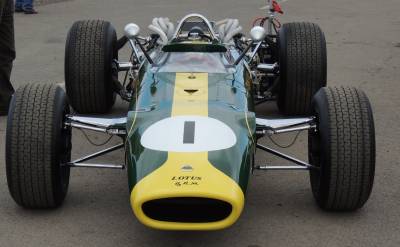 Lotus 43 - BRM H16
Lotus 43 - BRM H16
(Photograph - BRM Track Day, Blyton - 22
April 2015) ..................... More Photos in my Flickr album - BRM Track Day - Blyton 22 April 2015)
The H16 is often thought of as a glorious failure. In part, that may be the case. It was also a great British winner. The engine triumphed at the 1966 US Grand Prix in the richest race of that year's Championship.
At the start of the new 3 Litre formula of 1966 the Lotus team's preferred engine supplier (Coventry-Climax) had withdrawn from racing. Their own bespoke engine (the Cosworth Ford V8) would not be ready until well into the 1967 season. For 1966 the team would use oversize engines from the previous formula and become a "customer team" user of the 3 Litre BRM H16.
The Maurice Philippe designed car produced for the H16 engine was a monocoque ending behind the driver with the engine being a fully stressed member that supported the rear suspension and gearbox.
The Type 43 made its Grand Prix debut in the 1966 French GP. The Type 43 only finished one race - the 1966 United States Grand Prix. It won the race by over a lap! It was the only ever victory of the BRM H16 engine. Click here for the story of the race.
The last race of the Type 43 was the 1967 South African Grand Prix and later in the year at the Dutch Grand Prix the Type 49 Ford Cosworth DFV V8 raced for the first time. The two redundant H16 engined cars had their chassis modified for F5000 with the Ford V8 motor and were sold to Jock Russell and Robs Lamplough.
The US Grand Prix winning car (Type 43 R1) has been restored to original and working order and was first run in front of the public at the 2013 Goodwood Revival.
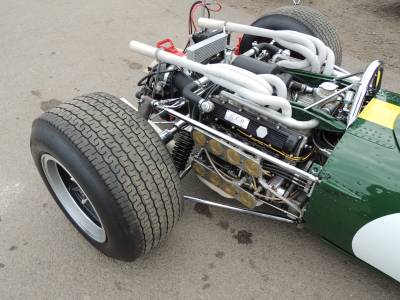
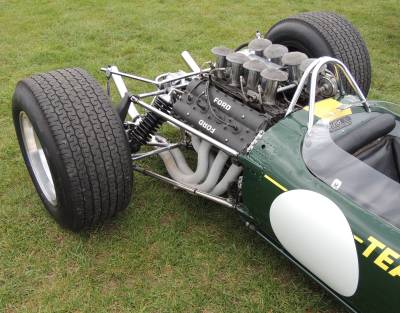 and then the Lotus
43 - BRM H16 became the Lotus 49 - Cosworth V8
and then the Lotus
43 - BRM H16 became the Lotus 49 - Cosworth V8
Is this how a good try developed in the one of the classic racers?
Take a bit of weight off the
engine
add a bit more power
use a little less fuel
make the car a little smaller
become reliable
and the result is a regular winner
compare the cars at my Flickr album - BRM Track Day - Blyton 22 April 2015
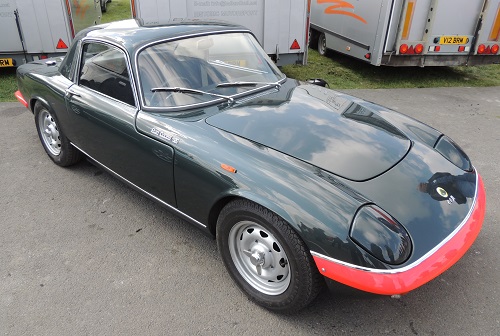 Lotus Elan BRM
Lotus Elan BRM
The light and small Elan of the 1960s provided a high performance
roadgoing two seat sportscar at a reasonable price. The racing
option for the Elan (Lotus 26R) could be provided with a BRM
tuned version of the four cylinder twin-cam Lotus-Ford engine.
One of the most active Lotus dealerships for this car was Mike
Spence (who just happened to have driven for the Formula One
teams of both Lotus and BRM.)
There were three versions of the BRM Weber
side-draft carburettor racing twin-cam.
Phase I - 145bhp. at 6,500 rpm.
Phase II - 200bhp. at 6,500 rpm.
Phase III - ? bhp. at ? rpm.
McLaren M4A - BRM V8 2.1litre
Formula One
One of the Formula Two chassis was rebuilt as a Formula
One car to fill the gap in early 1967. A 3in. extention in
wheelbase allowed the fitting of a BRM V8 2.1litre "Tasman"
engine. Extra fuel tanks were fitted to the chassis sides to
provide Grand Prix distances. The car got as high as second in
the twisty Monaco Grand Prix, finally finishing fourth after
being delayed by a flat battery. At the Dutch Grand Prix McLaren
retired on the first lap after spinning into the catch fencing.
The chassis was later burnt out and written off in an accident at
Goodwood.
McLaren M5A - BRM V12 3litre Formula One
The M4A-BRM was followed by the real 1967
Formula One McLaren - the M5A. This was the first use of the BRM
"customer" V12 whilst the works team were still using
the H16 engine. In the Canadian GP team owner, Bruce McLaren, up
to second place in the topsy-turvy rain-soaked race. What could
have been a magnificent win first time out became a finish
outside the points after a stop to replace a flat battery. The
power of the engine was shown by a front row grid position in the
Italian Grand Prix at the fast Monza track. The car was running
fourth when a broken connecting rod ended the run. The American
Grand Prix ended with a water hose failure. Mexican Grand Prix
provided a last place finish with overheating problems. The last
works use of the car was at the 1968 South African Grand Prix,
where Dennis Hulme finished fifth.
Privateer Jo Bonnier used the car until it became a wall-mounted
display in his home.
Mysteron-BRM
"Peter Warren, who added a roof with gullwing doors, and raced it as the Mysteron-BRM." ---- see WILLMENT-BRM
(From BRM - The Saga Of British racing Motors Volume 3 by Doug Nye)
Nomad-BRM
The Nomad Mk1 was a coupe first raced in 1967. The original engine was a Ford 1600cc 4-cylinder. Capacity was later raised to 1800cc and was then given a BRM V8 1500cc engine mid-way through 1968. In later life it reverted to a 1800cc Ford Twin Cam engine.
The Nomad Mk2 open car was built up with part cannibalized from a BRM formula 1 car in 1968.
The Nomad MK3 was another open car originally with a BRM V8 engine. Later used with a Ford V6 engine. After restoration the car returned to racing in 1998 with a Porsche 3.2 litre Carrera flat six engine Another restoration should see the car at the Le Mans Classic in 2018 back with a 2litre BRM V8.
Parnell-BRM
Pioneering BRM driver Reg Parnell, since retiring from driving in 1957, had served as team manager with Aston Martin and later with the Bowmaker Formula 1 teams, ultimately to create Parnell Racing for 1963. At the time of his premature death in January 1964 — following a botched appendectomy - he had begun a Formula 1 project with engineer Les Redmond. It died with Reg but the team survived, managed by his son, Tim Parnell. It was for him, through the winter of 1965—66, that Les Redmond devised a sports-racing car around a ‘2-litre’ BRM V8. The sleek, low Parnell-BRM, bodied by Williams & Pritchard, made its debut at the 1966 Easter Monday Goodwood meeting, in which Mike Spence gave the still-unpainted car a debut win. Spence and the Parnell-BRM then won again in the Anerley Trophy race at Whit-Monday Crystal Palace. Although forced to retire from the feature Martini Trophy at Silverstone in July, Mike led that day’s separate 25-lap sports car race until the BRM engine went off song and the Parnell ?nished 2nd.
(From BRM - The Saga Of British racing Motors Volume 3 by Doug Nye)
Raymond Mays 20 ..................... (Photos in my Flickr album - My Raymond Mays odds and ends)
As well of being the “Father” of BRM, Raymond Mays was “Father” of the ERA of the 1930s and also (less well known) the “Father” of a road car using his own name.
The vehicle was based on the Standard V8 “20 horsepower” model in both touring and coupe versions. The engine actually produced 85bhp. at 5000rpm. from it's 2686cc.
Shelsley Motors Ltd., Bourne produced the cars during 1938-1939 (when the Second World War intervened).
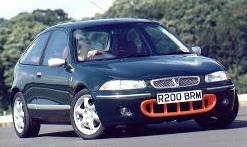 Rover 200 BRM LE
Rover 200 BRM LE
The photo is an publicity shot originally issued by the MG
Rover Group. Car owners will be found at "theBRM.co.uk"
Rover BRM forum.
..................... More Photos in my Flickr album - BRM Track Day - Blyton 22 April 2015
The road car, a special edition based on the Rover 200 / 25
range, was first publicly shown as a concept car at the Frankfurt
Motor Show in 1997 and was expected to be sold at around priced
at £18,000 on the road.
The three door hatch-back became available in April 1998 at about
£14,000. Originally the model was to be a special edition of 750
but finally a little over one thousand were produced. UK sales
amounted to 795 units. The Belgian market was allocated 50 cars.
The BRM model was given stiffer springs, lowered suspension, alloy 16 inch wheels and a Torsen limited slip differential. Gearing changes giving a close ratio gearbox encoraged the top end of the 1.8 VVC 143hp. rev range to be used.
The cars were painted "Brooklands Green" with chrome trim and a BRM "dayglow" orange nose. The interior was fitted with red leather and aluminium.
Scirrocco-BRM V8 1.5litre Formula One
Chassis produced - SP-1-63 & SP-2-63
Wealthy American teenager Hugh Powell brought into Emeryson Cars Ltd. to provide his guardian, racing driver Tony Settember, with a team to go Formula One racing for the 1962 season. The year with the Emeryson-Climax 4-cylinder was not a great success.
For 1963 Powell took full control of the team, renamed it “Scirocco-Powell” and developed a redesigned chassis to take the BRM-V8 that had taken the 1962 World Championship. Two chassis were built Scirocco-BRM (SP-1-63) for Tony Settember and later a narrower Scirocco-BRM (SP-2-63) for the team’s second driver, the narrower Tony Burgess. The team raced under the USA national colours of blue and white.
The cars’ greatest day was when Settember took Scirocco-BRM (SP-1-63) to a second place in the 1963 Austrian GP, only beaten by ex-World Champion Jack Brabham. The story was not quite as good as it seemed as the non-championship race only had three finishers and Tony was five laps behind Brabham.
Otherwise the year was no more successful than 1962 and by the end of Powell closed the team and both cars were sold. In 1964 Belgian Andre Pilette raced SP-2-63 with a Climax V8 engine and the Belgian national racing colour of yellow. Having being recovered from long-term storage in a Bristol mill in 1991 the chassis was later rebuilt by Hall & Fowler. Hall & Hall (as Hall & Fowler are now known) are restoring both chassis.
Talbot Sunbeam BRM
I spotted this advert - no other information currently available.
"This is UK’s monthly Performance Tuning dated October 1988, 84 pages. In this issue there is coverage on: The Hartwell BRM 16-valve Sunbeam Lotus Talbots are reviewed in an interesting article. Good engine photos…"
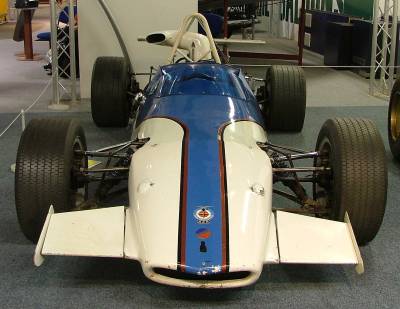
(photo left and right Jul
2009)
..................... More Photos in my Flickr album - My BRM odds and ends
The 1967 Techcraft-BRM at the Museum of British Road Transport, Coventry .
The car uses the Ferguson 4WD system and a 1500cc. BRM V8 Grand Prix engine.
The car is described ........
"RAC Hill Climb Champion 1967-1968 driven by Peter Lawson
Engine later enlarged to 1600cc and later still returned to 1500cc
Later raced by Roy Lane of Warwickshire who rebuilt the car."
The car was later used by Dave Baumforth.
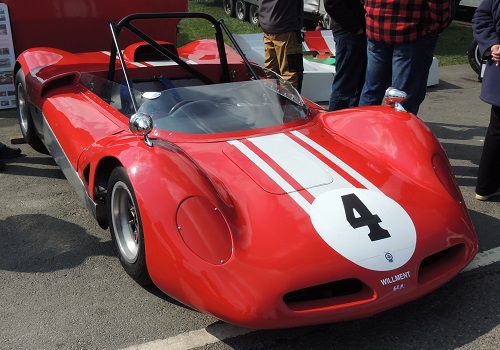 Willment-BRM
Willment-BRM
Best remembered today as an entrant of Ford saloon, GT and sports-racing cars, John Willment‘s Ford distributorship in Twickenham, west London, also built its own Climax-engined sports car in the 1950s, and in 1965 he had Brian Waite design a 2-litre contender using the V8 BRM engine. The new Willment-BRM featured a multi-tubular spaceframe chassis and Colotti gearbox, and it made its debut at the 1966 Easter Monday Goodwood meeting, facing the new Parnell-BRM, the Felday-BRM and Tommy Weber’s Lotus-BRM, plus all the usual Climax-engined suspects. Mike Beckwith out-quali?ed them all in the Willment-BRM but could only finish 4th. Veteran Formula 1 star Innes Ireland was then engaged to drive the car, but he was unable to start in the Oulton Park TT after the gearbox failed in practice, and he retired from the Silverstone Martini Trophy. But in August, with a ZF gearbox replacing the Colotti, he won the 2-litre Heat at Croft in pouring rain, followed by 4th in the Final amongst 6-litre Lola-Chevrolet T70s. in the Guards Trophy at Brands Hatch, Innes and the Willment-BRM finished 4th in Heat, but were unplaced in the Final. Hans Herrmann drove the car at the Norisring in Germany, but retired.
Willment had other plans for 1967, selling the sports car to Peter Warren, who added a roof with gullwing doors, and raced it as the Mysteron-BRM. In this form the car ran in the 1968 Nürburgring 1,000kms, co-driven by Ken Simmons/Howard Fawsitt. Simmons also drove this distinctive-looking — and sounding! — Coupé in British club events.
(From BRM - The Saga Of British racing Motors Volume 3 by Doug Nye)
(More Photos in my Flickr albums - have a look!)
V1.10 - 24 November 2023 ---- recommended resolution (1366 x 768)
© David Hodgkinson 2000-2023. All rights reserved.